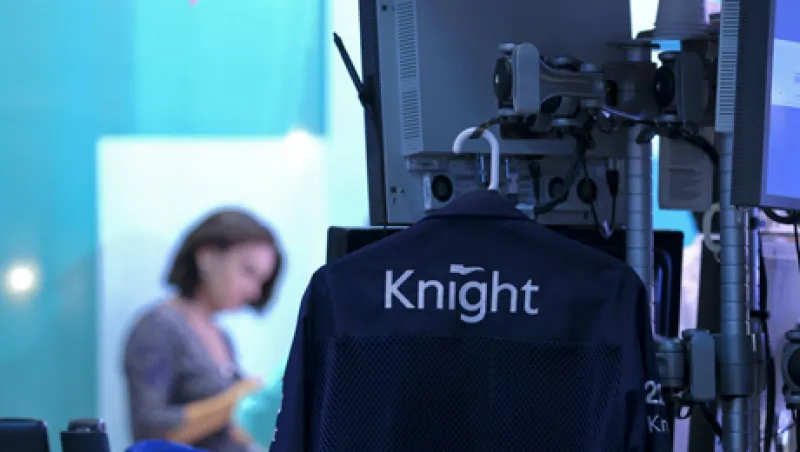Knight Capital is — or was — the largest market maker in exchange-traded funds. But the knock-on effects caused by Knight’s software debacle last week, dubbed the “Knightmare” by the Wall Street Journal, were effectively forgotten on waking.
“There was an irrational trader in the system, and the market did exactly what it should do with an irrational trader,” says Dave Nadig, director of research at IndexUniverse, the San Francisco–based ETF research firm. “It ate them for lunch.”
Nadig says that prior to last Wednesday’s astounding high-speed loss of $440 million, Knight was doing a better-than-average job of maintaining tight bid/ask spreads in thinly traded ETFs, defined as those that trade less than 50,000 shares per day. Knight is the lead market maker (LMM) on 418 ETFs on the New York Stock Exchange’s Arca platform, with 150 in the low-volume category, he says.
Using a universe of about 900 ETFs on NYSE Arca that have LMMs (not all do), Nadig calculates that in the two days prior to Knight’s August 1 meltdown, the average spread on all thinly traded ETFs was 73 basis points, but for those where Knight was the LMM, it was 61 basis points, he says. On Wednesday and Thursday, during the worst of the crisis, the average widened to 94 basis points, with Knight at 115, he says. By Friday, with other market makers stepping in, the average had dropped back down to 85 basis points, and Knight was just over that, at 86, he says.
That may not seem like much, but Nadig says the episode is “validation of the importance of having strong lead market makers.” He says that “to those who’ve questioned whether having lead market makers matters all that much, what we’ve seen here is: Yep, it definitely does, because when they step out a little bit, spreads widen out significantly.” He also notes that with “the more liquid ETFs, the market stepped in and provided liquidity perfectly.”
And, he says, “It’s always good advice to suggest a substantial amount of caution in trying to trade illiquid ETFs.” Never put in market orders; always have a limit, he says, adding: “That’s just ‘Fundamentals of Trading 101.’”
But John Hyland, the chief investment officer at United States Commodity Funds (USCF) of Alameda, California, and the chairman of the newly formed National ETF Association (Netfa), says it looks like “not many ETF investors/traders were hurt much by this event.”
“This seems to be really about Knight shooting their foot off,” he says in an email.
Hyland reports that the only one of USCF’s twelve ETFs that was impacted was UNG, the United States Natural Gas Fund. He adds that it appears to him that Knight bought anywhere from 20 million to 25 million shares at prices that were anywhere from two cents to eight cents over market value. “Not a horrible execution per se,” he says in his email, though he added that such volume “certainly” helped contribute to Knight’s $400 million plus loss. Hyland says that on that one day, UNG traded a total of about 40 million shares compared to its usual 12 to 13 million shares. Most of the buying by Knight was unwound by the sellers the same day or the next day, according to Hyland.
On the morning of August 1, the Vanguard Utilities ETF (VPU) also spiked very dramatically. It traded over 5 million shares in a roughly 6-minute period around 10:00 a.m., compared to its three-month daily average around 70,000 shares, Vanguard spokesman, David Hoffman writes in an email.
Hoffman also says that according to preliminary lists from NYSE, there were requests for reviews of clearly erroneous executions (CEEs) in three Vanguard ETFs: VPU, VSS (Vanguard FTSE All World ex U.S. Small Cap ETF), and VCR (Vanguard Consumer Discretionary), though the last two did not experience abnormal premiums or trading volume.
Hoffman adds that the preliminary NYSE CEE list also identifies nine non-Vanguard ETFs as being affected, including the iShares Silver Trust (SLV), the iShares Barclays TIPS Bond Fund (TIP), and USCF’s UNG. He says that after a review, the decision was made by NYSE to allow all trades to stand and did not cancel trades in any of the above-mentioned exchange-traded products. The NYSE declined to comment.
Hyland notes that Knight’s prominence in the ETF market is relatively recent, due to the year-end 2010 acquisition of the LMM and DMM (designated market maker, the term used by Nasdaq) business of Kellogg Capital Markets.
Up to that point, he says, Knight was a very small player in the ETF space, while Kellogg was in the top two, he says. Knight then substantially reduced the number of traders who worked in that unit in favor of “better technology,” he says.
“The bad news is that when the technology goes kerblewie, you do not have as many human eyes looking around and saying: ‘Hey, that’s funny, what’s going on?’” he says in his email. “I am going to guess that the other ETF market makers knew something was wrong and jumped on the trades to take advantage of it, long before Knight realized something was wrong.”
On Monday, Knight got a cash infusion in the form of a $400 million equity financing from a group of six investors. The deal was arranged by Jefferies, the investment bank, and included Blackstone, the buyout firm; rival market maker Getco; Stephens; Stifel Financial; and TD Ameritrade.
Hyland wonders how much of Knight’s losses ended up “in the pockets of some of their ‘rescuers’ like Getco and Jefferies.” They both make markets in ETFs and “both apparently just provided some very expensive capital to Knight,” he says. Wouldn’t it be “positively ironic” if they just bought “a big chunk of Knight using money they just made trading against them?” he asks. Adds Nadig: “It wasn’t my grandmother picking up those trades from Knight. It was most likely another market maker.”
Knight Capital did not respond to calls asking for comment.






